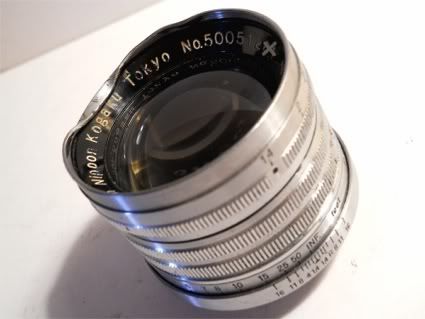
There's my #5005 on one of my two
"user" 1945 chrome Leica IIIC K's, complete with electrical taped Walz UV filter and Walz Nikkor f1.4 hood
(remember it has a really messed up/bashed in filter ring) - my lens is like serial number #500512xx something like the end of the line for the 1950 Nikkor SC LTM's .......sorry I forgot to photograph the plastic cap, I'll get a shot of it lateron
🙂
There's a shot of the damage...........I asked Essex camera if they could fix it they said yes, but I am worried that the rim/ring will crack apart/split if they try? - The front ring BTW is like a touch smaller than the later "Japan" lenses and cannot be swapped out, I guess when I think about it, it's not worth the risk of busting the ring up in repairs, I might be smarter if I just leave well enough alone?
I have the inner part of the dent painted flat black now
(to avoid any cross/bounce glare from the damaged part) and the tape works fine and a IR/CUT filter screws right in too, so I use the lens in both real film and Leica digital on the M8.
Youxin just sold one of these on evilbay last week for $455 (a very good price) it had slight filter rim damage (that was nicely repaired) *see below*
They are quite hard lenses to find in clean/minty condition, but even mine as beat up as it looks, shoots great, I really like the look of the signature/bokeh of the early Nikkor NKT lenses.
😀
Tom
PS: I hope that someday I will find a a "user" example of a Nikkor f1.5/50, though they are very uncommon and rarely turn up for sale online.....I have to get lucky at a garage sale
😉







